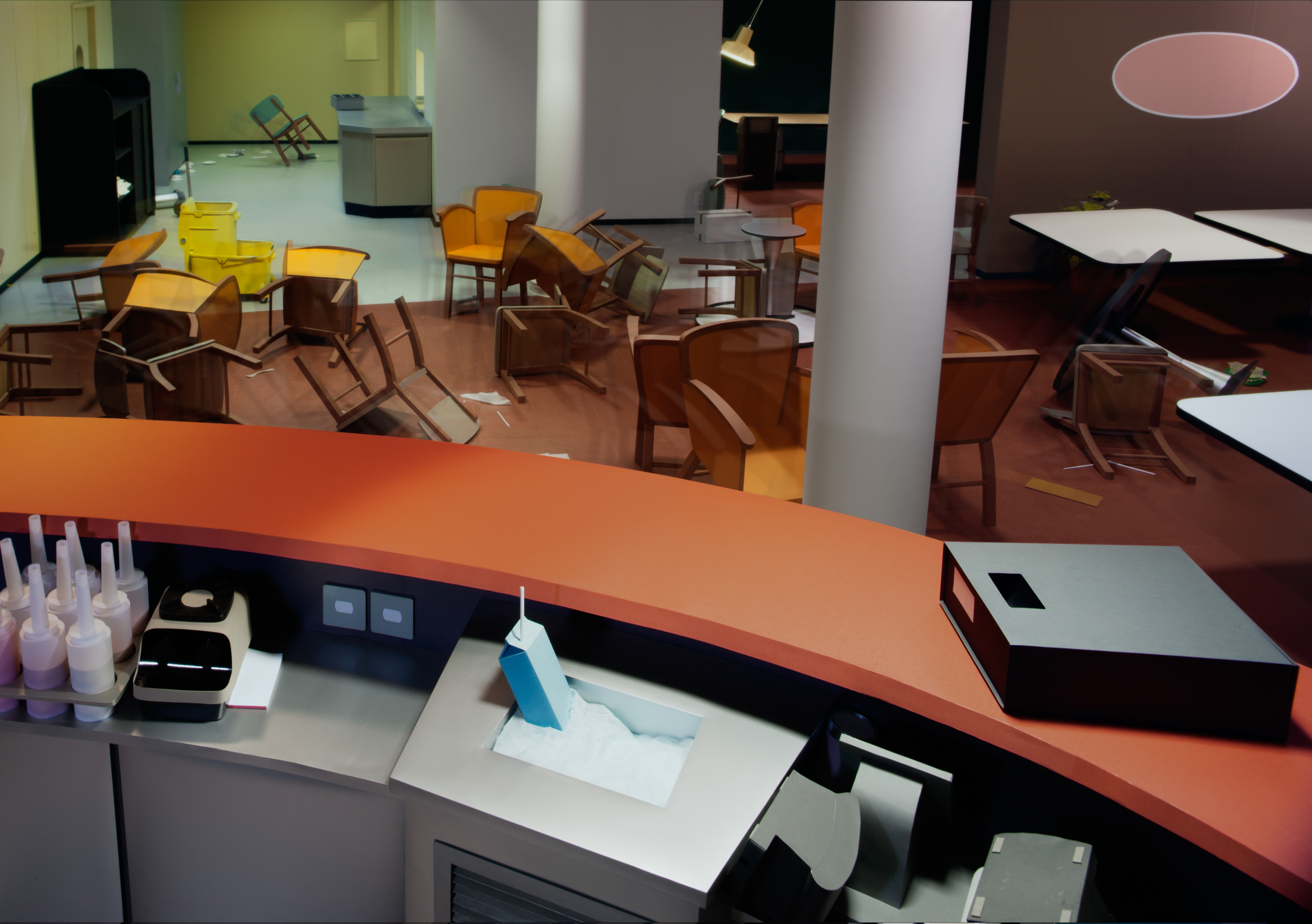Walking into Thomas Demand’s Embassy (2007), it is easy to empathize with the uneasiness the artist must have felt when visiting the titular Embassy of the Republic of Niger in Rome to prepare for this series. Frameless, life-size prints, appearing as part of the wall they are mounted on, depict doors ajar and offices in disarray, as if tracking the movement of a burglar. Papers scattered across an office desk look uncannily blank, until one realizes that blankness permeates the whole series—the scattered documents are the best representation of a world constructed entirely out of paper.
The origami building is typical of Demand’s meticulously constructed realities, which have won him international fame, including headline exhibitions in Germany and the United States. A new show, at DHC/ART in Old Montreal, displays Embassy alongside five similarly fabricated film installations, collectively titled Animations.
Demand typically culls his material from cultural or political events that he feels can be accurately embodied by an image. Instead of photographing an object directly, however, he applies distance by manufacturing the piece in question before taking its portrait. In Animations, he manipulates paper, three-dimensional animation, and even candy wrappers to create eerie facsimiles.
The artificial universe Demand has created is striking because of its—quite literally—dishonest take on art’s persistent goal of showing people different perspectives of reality. At first, the work seems like an elaborate prank, mocking the ‘true’ claim of photography, and testing the perception of its audience. Films like Rain (2008), which depicts “raindrops” with stop-motion animation of candy wrappers, seem whimsical, with the illusion itself as both the departure and final destination of the work’s purpose. Other projects like Embassy and Pacific Sun (2012) resonate more effectively because they flesh out specific events, ironically adding new layers of meaning to the reality they depict by subtracting information—Demand’s artificial universes are devoid of people.
Revisiting the Nigerien Embassy adds visual data to an alleged break-in in 2001. Official etterhead was apparently stolen, and used to forge contracts between Saddam Hussein and Niger over the purchase of “yellowcake” uranium, later used by George W. Bush as evidence to go to war in Iraq. Just like the documents, the embassy is itself a forgery, and the photos question the authenticity of intelligence, following a paper trail of conspiracy theories, just to end up with more paper
Demand’s fakery extends to the peripheral environment of the gallery as well. The artist surrounds much of it in wallpaper in the pattern of a grey curtain. Whether intentionally or not, walking through DHC/ART’s sparse stairwells, and being constantly watched by security guards in an uncomfortably enclosed space (Embassy is spread over two small floors) adds to the effect of the work. While trying to listen to Demand talk about being kicked out of the embassy for taking photographs, a guard pointed to my recorder and warned: “Pas de cellulaire.”
In a conversation with Demand prior to the exhibit’s opening, art critic Michael Fried claimed that the process of meticulously assembling his environments was crucial to the meaning of his work, and that there was importance in the fact that nothing was accidental. He relished the fact that such deliberateness meant that every detail served a purpose, and that the sum of those details communicated an unambiguous statement to the audience. Simultaneously, however, he claimed that context was secondary to this process of fabrication, a claim supported by the gallery in its assertion that Demand’s sets are destroyed after they are photographed. This awareness, combined with knowledge of the political context of the embassy photos adds layers of both complexity, and clarity to Demand’s intentions.
Without knowing about the embassy break-in, or that Recorder (2002) is based off the unfinished Beach Boys album Smile, does the art have the same weight? Demand argues that it does, and seems to welcome ‘ignorant’ interpretations of his pieces, historically providing no revealing information in his titles. Yet, it is hard to let Demand have his cake and eat it too; and while DHC/ART’s eagerly in-depth explanations of context is helpful to an audience, it feels cautious and antithetical to Demand’s statement. Despite this, the gallery may still be doing us a favour by providing explanations to latch onto, even if some of its artist’s mystique is lost. So who can be trusted? As Animations suggests, perhaps no one.
Thomas Demand: Animations runs from Jan. 19 to May 12, 2013. The exhibit is hosted by DHC/ART (451 & 465 St-Jean Street). Admission is free.







